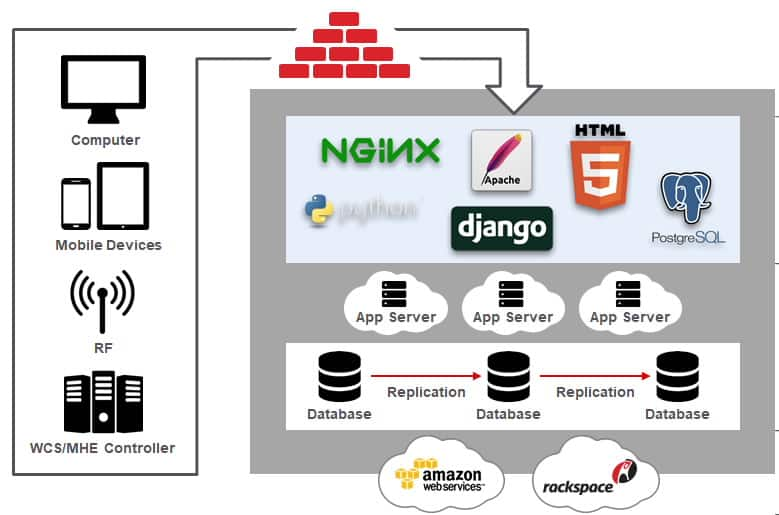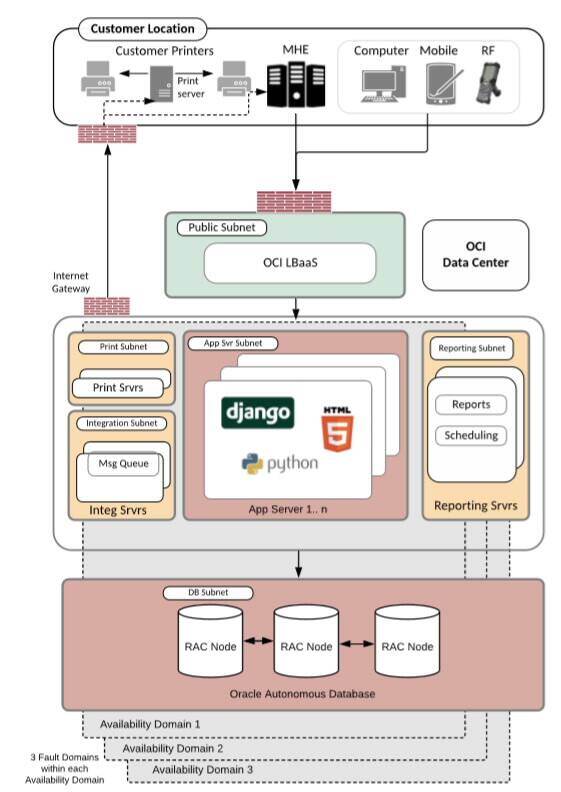Why do Autonomous Database applications perform better than PostgreSQL on AWS? - Course Monster Blog

In today’s customer-centric world, organizations find it difficult to grow their user base while meeting their customers’ speed, agility, and personalization needs—but that’s exactly what LogFire was able to do when it switched to Oracle Autonomous Database, a next-generation cloud platform with a fully automated database. LogFire raised order processing rates by 55% in a year while expanding its customer base by 2x. LogFire also decreased its TCO by utilizing Autonomous Database auto-scaling technology, going from ten external contractors administering the database to zero—the database automates all manual activities. LogFire now processes approximately 5 billion packets each year and is trusted by hundreds of clients worldwide. LogFire was also able to swiftly construct more features and customizations with Autonomous Database to grow into 10 new industries.
This blog will discuss how LogFire (now branded as Oracle Warehouse Management Cloud) migrated its cloud-native, mission-critical SaaS application to Oracle Cloud Infrastructure (OCI) and migrated all of its AWS PostgreSQL databases to Oracle Autonomous Transaction Processing (which also runs on OCI) for improved performance, elasticity, security, and TCO.
Oracle Warehouse Management Cloud, Born from LogFire
Oracle Warehouse Management Cloud is a leading cloud-based inventory and warehouse management service that assists organizations in automating numerous supply chain processes. LogFire, a pioneer in introducing cloud to supply chain management, was created in 2007 by Diego Pantoja-Navajas and was acquired by Oracle in 2016 as the foundation for Oracle WMS. “With the goal of revolutionizing supply chains by assisting organizations in adopting cloud technologies, we designed a standalone SaaS application that connected different systems and data to remove silos and make supply chains more efficient,” Diego explained during our chat. We were always aware that we were creating a mission-critical application for the heart and lungs. Because so many different types of enterprises would rely on it, it had to be bulletproof.”
Issues with Amazon Relational Database Service (RDS)
LogFire’s application used current cloud-native development approaches, with production databases on Rackspace running PostgreSQL. Arun Murugan, VP WMS Product Development, stated that they transferred their PostgreSQL test databases to Amazon RDS to save money, but maintained production on Rackspace and outsourced administration because LogFire did not have an in-house DBA staff. “While RDS eased scalability, it had performance and reliability issues that made it unsuitable for our production databases.” These issues included “no performance guarantees, manual tweaking of a huge number of database settings to maintain performance levels, no automatic bi-directional database replication, security vulnerabilities, patching and maintenance downtimes, and more,” added Arun.

LogFire’s architecture before moving to Oracle Cloud Infrastructure
Why LogFire Moved their Applications and Databases to Oracle Cloud Infrastructure
The supply chain, like any other business, is undergoing massive changes. The great toilet paper crisis of 2020, which coincided with the COVID-19 pandemic, showed another gap in the global supply chain. Social media exposure, the growing emphasis on customer experience, sustainability, ethical vendor conduct, and the circular economy have all had a significant influence on changing the supply chain from a back-office function to a more strategic differentiator. As a result, the importance of the supply chain was increased across sectors, and LogFire experienced a boom in demand that put a lot of strain on its previous design. LogFire prioritized innovation and modernization of its supply chain for its customers:
- They were unable to provide new features at the rate demanded by their customers.
- They were spending a growing amount of time manually maintaining their databases to assure their clients’ 24/7 availability.
- Most importantly, Rackspace’s production PostgreSQL databases were unable to scale up and down as quickly in response to seasonal peaks in demand as well as the yearly growth in shipment quantities of its retail customers. Despite the fact that their program could scale dynamically, scaling and upgrading the databases required downtime, making the databases inaccessible and slowing down the whole process. They had to prepare ahead of time and acquire more Rackspace servers before each seasonal peak, then manually scale down at the conclusion of the season. Scaling on AWS also necessitated downtime.
Because these basic difficulties were impeding its expansion, LogFire began examining other possibilities that may meet its business objectives. After analyzing all of the benefits, they decided to transfer their application and databases to OCI in the summer of 2019. They converted all 700 PostgreSQL databases to Autonomous Transaction Processing, an Oracle Autonomous Database optimized for OLTP, after a comprehensive evaluation of several possibilities for operating PostgreSQL databases on OCI, or Oracle Autonomous Database.

Oracle Warehouse Management Cloud architecture on Oracle Cloud Infrastructure
Seamless Migration Process
The conversion of LogFire’s application and database to OCI and Autonomous Database took slightly over 7 months. If not for the delays to minimize any inconveniences for its retail clients during their seasonal peaks, the full move would have taken less than three months. They had switched their whole application stack and all of their clients on OCI by February 2020. The following criteria helped all 700 databases migrate successfully.
- LogFire’s application was created with a modern cloud-native REST services-based architecture. Just because of that, moving to OCI was as simple as raising and shifting the application code to Oracle’s cloud-native services without significant re-architecting or rewriting of the code. They used API calls to connect to a number of non-standard systems to automate package selecting, packaging, sorting, and shipping. Moving their 700 PostgreSQL databases was the same as changing the core database technology without the need for additional integrations.
- The Django object-relational mapper (ORM) is used in LogFire’s application architecture to create a database separation layer, allowing queries to be database-agnostic. This meant that 75 % of the SQL queries created by the ORM could be sent to Oracle “as is.” Only 25% of the hand-coded queries required some level of tweaking for Oracle Autonomous Transaction Processing.
- Because PostgreSQL and Autonomous Transaction Processing are both SQL-based, LogFire developers and users had a relatively low learning curve because ATP automates the majority of the operations.
How the Move to ATP from PostgresSQL Propelled LogFire’s Growth
55% increase in order processing speed: Warehouse management systems are real-time transaction systems in which order delivery is directly affected by performance and availability. Several systems, robots, and machines make continual API calls to the database to complete a single order. As order volumes grow, database failures or slower response times have an impact on income and, eventually, reputation. Only Autonomous Transaction Processing could meet these high-performance standards. However, switching to OCI raised LogFire’s clients’ order processing rates by 55%, while goods sent increased by 45% year over year.
50% increase in warehouse users: Diego stated that after migrating to OCI, LogFire was able to grow from five industries to fifteen, expanding its customer base and increasing warehouse users by 50% in just one year. Because their workers had access to all data and could focus on development rather than managing the database and supporting infrastructure, they were able to quickly introduce new features and modifications for these new sectors. Autonomous Transaction Processing allowed this expansion by enabling auto-scaling at the press of a button, even during seasonal peaks when LogFire’s customers doubled their users.
In fact, during the start of the pandemic, most of their clients’ shipment volumes exceeded their seasonal peaks. LogFire was also able to satisfy the unanticipated rise in demand efficiently and without disturbance. The auto-scaling functionality of the Autonomous Database may automatically scale up or scale down the number of CPUs based on workload needs, resulting in cost savings through real pay-per-use.
TCO Reduction: LogFire decreased its ownership costs by transitioning from a remote database management service with 10 contractors continually monitoring all of their databases to a completely automated system. Autonomous Transaction Processing automated all of its processes, allowing for error-free 24/7 monitoring and avoiding continuing maintenance costs for patching, protecting, and backing up the databases.
Zero Downtime: PostgreSQL databases hosted on AWS or Rackspace required scheduled downtime for patching, upgrading, and maintenance. Autonomous Transaction Processing grows dynamically while transactions are in flight, automatically installs updates with no downtime, and does not require planned maintenance. It generates and manages multitenant environments automatically, manages clusters, and implements Oracle Maximum Availability Architecture (MAA). The Autonomous Data Guard (Auto-DG) function, which may be activated with a single click, automatically produces a standby duplicate of the active database.
In the unlikely event of an interruption or outage, the database layer can instantly transition to the standby database. Rather than waiting for the primary database to recover, application transactions can continue to run without interruption on the promoted backup database. Transparent Application Continuity improves the availability of the database that is already running on Oracle Real Application Clusters (RAC). These features enhanced LogFire’s uptime SLA, assuring zero downtime.
Enhance Security: LogFire improved its security posture after switching away from PostgreSQL. Their data was secured only during transmission using AWS RDS for PostgreSQL. Transparent Data Encryption (TDE) is used by Autonomous Transaction Processing to encrypt data both at rest and in motion. It uses machine learning to automate the detection of security risks. It also offers more granular security to do assessments, disguise sensitive data, and audit actions in order to secure customer data. Security fixes are also applied automatically.
Machine Learning-based automation: By exploiting the in-database machine learning techniques available with Autonomous Transaction Processing, LogFire was also able to distinguish and deliver unique value to its clients. They used over 150 distinct AI/ML algorithms without the help of any data scientists. The following are a few AI/ML algorithms that they implemented:
- Predicting peak hours in distribution centers
- Calculating average picking times and expected task time
- Replenishment (automatically initiating efficient replenishment tasks)
- Calculating expected profit from each order fulfilled or average revenue generated per order
- Predicting future target values
- Creating predictive pick orders based on historical data
- Automatically assigning order fulfillment priority
- Clustering employees who work well together to optimize efficiency
- Warehouse slotting
- Spotting worker efficiencies
Here at CourseMonster, we know how hard it may be to find the right time and funds for training. We provide effective training programs that enable you to select the training option that best meets the demands of your company.
For more information, please get in touch with one of our course advisers today or contact us at training@coursemonster.com




Comments ()